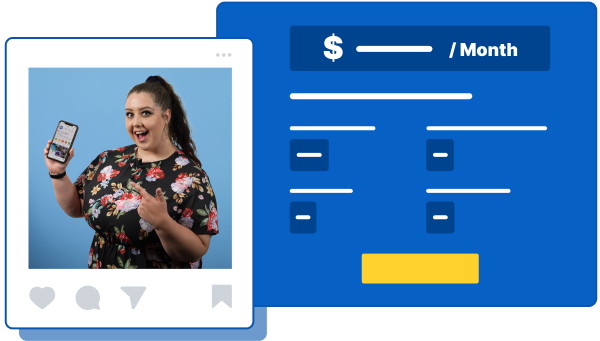- Home
- Blog
- Social Media Social Media Automation: What It Is, Why You Need It, and Which Tools to Use
Social Media Automation: What It Is, Why You Need It, and Which Tools to Use
-
 9 min. read
9 min. read
-
 Sam Wixted
Sam Wixted Content Writer
Content Writer
- Sam has been writing for WebFX since 2016 and focuses on UX, crafting amazing website experiences, and digital marketing In her free time, she likes to spend time on the beach, play with her cats, and go fishing with her husband.
Existing on a variety of social media platforms is vital for your business, no matter your industry. However, providing your audience with content on multiple social media platforms can be exhausting — not to mention difficult.
But that’s where social media automation comes in. Social media marketing automation allows you to systematize your social media presence and make better use of your time on other marketing channels.
But what is social media automation?
Why should you use social media automation? What are the best social media automation tools?
On this page, we’ll answer these questions and more, so keep reading. And if you’re interested in getting social media tips sent straight to your inbox, don’t forget to sign up for our Revenue Weekly newsletter!
Social media automation FAQs
Let’s start by answering some of the most popular social media automation questions.
What is social media automation?
Social media automation is the process of systematizing your social media presence so that you can spend more time on other areas of your marketing.
It’s a common misconception that social media automation only refers to scheduling your social posts.
There are also many other areas of your campaign that you can automate. We’ll get to those later!
What are the benefits of social media automation?
If you’re on the fence about using social media marketing automation, we’ve got a few reasons why you should consider it. Below are just some of the benefits that come with social media automation:
- It allows you to be present on a variety of platforms
Social media automation is especially beneficial if you’re present on more than one social media platform. You likely post slightly different content on every network, which can make it confusing to know when, and what, you’re posting to each one. Automating your social media campaign allows you to schedule posts on various platforms so that it’s easier to keep track of platform-specific content and schedules.
- It ensures consistency
Users can find you less trustworthy if you don’t post consistently. Plus, a few posts per month won’t necessarily keep you top-of-mind. With social media automation, you can schedule posts ahead of time to ensure you post consistently on all platforms.
- It allows you to build real relationships
When you spend most of your time manually posting to social media or building reports for your team, it can be challenging to build one of the most important aspects of social media marketing — customer relationships. With the free time that social media automation provides, you’ll be able to focus on building real relationships with clients through direct messaging, comments on posts, and more.
How much does social media automation cost?
The cost of social media automation depends on the automation tools you choose to employ. If you plan on automating social media on your own, the tools involved could cost anywhere from $25 per month to upwards of $600 per month, depending on your business’s size and the features you want.
Having said that, it’s worth considering whether you’d like to manage your social media automation on your own, or if you’d like to get an agency involved to help.
A social media marketing agency can help you further manage your social media presence — not just automate social media posts and reports.
If you’re looking to round out your social media marketing efforts, hiring a social media marketing agency is a great option. Social media marketing services typically range from $1000 per month to $5000 per month. The exact price depends on how many platforms you have and if you plan to use paid advertising, among other things.
What are the best social media marketing automation tools?
There are a variety of social media automation tools you can use to help streamline your strategy.
Some of the best such tools include:
- Buffer: Buffer allows you to manage Facebook, Twitter, Instagram, Pinterest, and LinkedIn accounts. Platform features include a publishing queue, a reply feature to boost engagement, results monitoring, and the ability to add team members to your account.
- Sprout Social: Sprout Social supports accounts on Facebook, Twitter, Instagram, and LinkedIn. It provides similar features to Buffer. It also features an analytics platform to dig into campaign performance, a social inbox, social media monitoring, and more.
- Hootsuite: Hootsuite allows you to manage accounts on Facebook, Twitter, Instagram, LinkedIn, YouTube, and WordPress. Its features include bulk content uploads, content curation, analytics, and team management.
- SocialPilot: SocialPilot supports Facebook, Twitter, Instagram, Pinterest, LinkedIn, and Tumblr. Its features include things like bulk publishing, auto-publishing, analytics, and inbox moderation.
Your social media automation strategy
So, how do you construct a social media marketing automation strategy with all the info we’ve provided? Check out our step-by-step tutorial to building a social media automation strategy below.
Step 1: Decide what platforms you want to automate (and to what extent)
Most likely, you’ll want to automate strategies for each of your social platforms. It can become confusing only to automate select networks, so we recommend automating them all.
However, there are special considerations when deciding which platforms make the cut or exactly how much content to automate.
For example, if you are a handmade bracelet company with an Instagram account, you might thrive on posting progress pictures of your homemade bracelets. Platforms that you post on in real time might not be the best candidates for full automation, but there is still room to tighten up your strategy.
For instance, you can still post in real time on platforms like Instagram, but you can also weave in an automated campaign that posts curated content weekly to keep your account from running dry when you’re not working on a project. Additionally, platforms with the “Story” feature encourage real-time posting — which you won’t be able to automate.
Action item: Take notes on which parts of each platform’s strategy you want to automate.
Step 2: Determine what you want to automate
As we mentioned before, social media automation isn’t just about automating post times.
You can automate a variety of things, like:
- Post scheduling: Social media marketing automation is most well-known for automating posts. Social automation tools help you schedule posts well in advance so you don’t have to post them manually.
- Chatbot conversations: Using a chatbot to answer FAQs for your business is a huge time-saver. They also help your business be responsive and timely without lifting a finger.
- Analytics reports: If you’re monitoring the results of your social campaigns (which you should be!), you can automate analytics reports to share with your team to save yourself time compiling all the numbers.
In most cases, you’ll want to take full advantage of all the automation options to free up as much of your time as possible.
Action item: Determine which processes you want to automate.
Step 3: Research social media marketing automation tools
After you decide which processes you want to automate, you can start researching social media automation tools. You’ll want to find a tool within your budget that integrates with all the social platforms you use. Not only that, but you’ll want to make sure that it supports all the automation strategies you plan to use.
Action items: Make a list of your top two social media automation tools.
Step 4: Look at previous content to determine optimal times to post
Social media marketing automation is all about using consistency to your advantage — but if you consistently post at the wrong time, you’ll miss out on one of the best benefits.
To determine the right time to post content, look back on previous posts to see when you get the most engagement on each platform.
Action item: Note the times of day when your posts get the most engagement on each platform.
Step 5: Determine which content formats get the most engagement
Every social media platform is different, and it’s essential to pay attention to what kind of content users consume on each. For example, you might realize that videos get more engagement on Facebook than Twitter, or that followers are more likely to click a link on LinkedIn than Facebook.
Making these distinctions early on will allow you to post the content that users want on each platform, leading to increased engagement across the board. You can use each social platform’s baked-in analytics platform to determine what kinds of posts get the most engagement.
Action item: Determine which content formats work best on each platform and create a list of each platform’s top three highest-performing content formats.
Step 6: Create your content and a content calendar
You’ll need content to post, so the next step is to create the content based on each platform’s needs.
Whether you want to post images, videos, or links to your blogs, you’ll want to have a healthy backlog of content to schedule on your social media content calendar. If you’re having trouble creating all the content you need for your social platforms, an agency like WebFX can help. We specialize in:
After you create your content, you’ll want to evenly disperse it on your social media calendar before scheduling it in any tools. Don’t forget that since different content formats work better on different platforms, you’ll likely want to have a calendar for each of your social networks. This will help keep you organized and ensure that your schedule is in more than one place.
Action item: Create a wealth of content to schedule on your social media calendar, and if you need help, reach out to an agency to employ their services.
Step 7: Schedule your content
After creating your content and filling your content calendar, it’s time to use your content calendar as a guide to fill your publishing queue on your tool of choice.
You should work on scheduling one platform at a time to keep all your content in order.
Action item: Upload your content into your social media marketing automation tool of choice.
Step 8: Rinse and repeat
You want to make sure that you don’t schedule your social media content for more than a month at a time, simply because content can become outdated. This means you’ll be repeating this process at least 12 times per year!
Action item: Create a list of evergreen content to fill the gaps where you don’t have new content ready to post.
Do you need help with social media marketing automation?
If you’re still scratching your head about how to work social media automation into your current campaign, WebFX can help. With more than two decades of experience, our social media team has the experience necessary to help you automate parts of your social campaign that take up your time.
To learn more about our social media marketing service plans, give us a call at 888-601-5359 or contact us online!
-
 Sam has been writing for WebFX since 2016 and focuses on UX, crafting amazing website experiences, and digital marketing In her free time, she likes to spend time on the beach, play with her cats, and go fishing with her husband.
Sam has been writing for WebFX since 2016 and focuses on UX, crafting amazing website experiences, and digital marketing In her free time, she likes to spend time on the beach, play with her cats, and go fishing with her husband. -

WebFX is a full-service marketing agency with 1,100+ client reviews and a 4.9-star rating on Clutch! Find out how our expert team and revenue-accelerating tech can drive results for you! Learn more
Twitter and Facebook Status Generator
Finding engaging social media content for your business can be difficult. Use our tool to quickly find ideas and post directly to your page.
Give Me an Idea

Social Media Cost Calculator
Use our free tool to get a free, instant quote in under 60 seconds.
View Social Media CalculatorTwitter and Facebook Status Generator
Finding engaging social media content for your business can be difficult. Use our tool to quickly find ideas and post directly to your page.
Give Me an Idea





